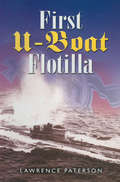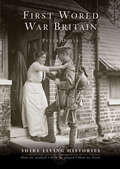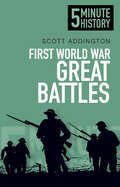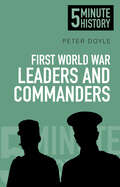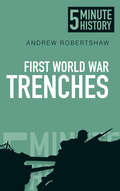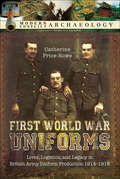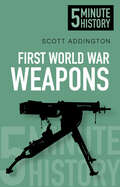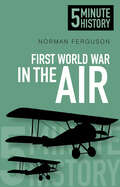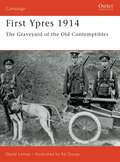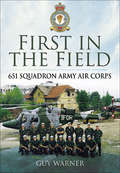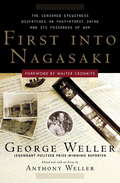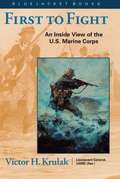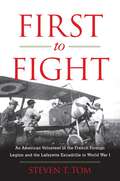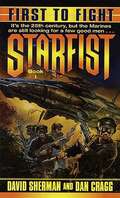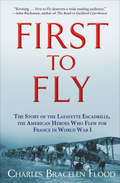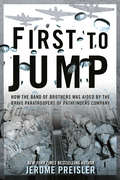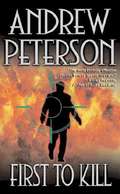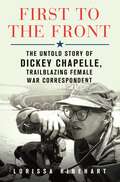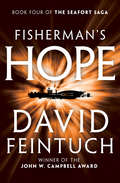- Table View
- List View
First They Killed My Father: A Daughter of Cambodia Remembers
by Loung UngUntil the age of five, Lounge Ung lived in Phnom Penh, one of seven children of a high-ranking government official. She was a precocious child who loved the open city markets, fried crickets, chicken fights, and sassing her parents. While her beautiful mother worried that Loung was a troublemaker -- that she stomped around like a thirsty cow -- her beloved father knew Loung was a clever girl. When Pol Pot's Khmer Rouge army stormed into Phnom Penh in April 1975, Ung's family fled their home and moved from village to village to hide their identity, their education, their former life of privilege. Eventually, the family dispersed in order to survive. Because Loung was resilient and determined, she was trained as a child soldier in a work camp for orphans, while other siblings were sent to labor camps.
First Through The Clouds: The Autobiography of a Box-Kite Pioneer
by Frederick Warren MerriamThe early years of aviation were marked by flimsy, unreliable machines and daring adventurous young men. One of the pioneer aviators leading the way in Britain was F. Warren Merriam who, following Louis Blriots first flight across the Channel in 1809, joined the Bristol and Colonial Aeroplane Company through which he obtained a Royal Aero Clubs aviators certificate.Much of the flying training in those early days was a case of the blind leading the blind and, as Merriam wrote, Flying was a dangerous business then. Airplanes were constantly breaking up in the air let alone on takeoff and landing; there were no parachutes and the pilots were ever expectant of mishaps. This was hardly the career for a decent young man and for a long time he had to keep his flying a secret from his parents.Aviation did indeed develop into a career, with Merriam becoming a certified instructor at Brooklands aerodrome. There he taught many of the men who became pioneers in aviation and others who joined the Royal Flying Corps that crossed to France in the early months of the First World War.The term pioneer could also be ascribed to Merriam for he was the first person in Britain to fly through the clouds. Until that day in 1912, it had been assumed that pilots would always stay within sight of the ground. Why would anyone want to go so high?This entertaining autobiography takes the reader on a journey through Merriams early flying career, from how it started through his first shaky solo, through a series of crashes into his First World War service. His account is the story of the early history of aviation, the development of aircraft and the personalities that led the way in those exciting, if risk-strewn days of yore.
First Winter on the Eastern Front (Stackpole Military Photo Series)
by Michael Olive Robert J. EdwardsPhoto chronicle of the German-Soviet campaign on the Eastern Front during its first brutal winter after Operation Barbarossa ground to a halt outside Moscow.
First World War Britain
by Peter DoyleWhen Britain declared war on Germany in August 1914, most expected the war to be over by Christmas, and only a handful forecast the length of the conflict, or the impact it would have on a civilian population whose experience of war to date had been reading of the exploits of the British Army in distant Sudan or South Africa. The First World War would change British society, often irrevocably and sometimes for the better, but it also brought hardship and fear. Rationing, government restrictions, censorship, and bombardment from both the sea and air, meant that for the first time, civilians found themselves part and sometimes victims, of 'total war'. Shopkeepers might boast that it was business as usual, but nobody could ignore the social upheaval, the restrictions introduced by new legislation or the strains and privations facing day-to-day existence. Nonetheless, the war also saw Britain galvanise itself in a collective effort to increase industrial productivity, domestic self-sufficiency and reduce waste - all key factors in helping to win the war. Lucinda Gosling explores how the people left at home adapted their lifestyles to meet the challenges of the time, looking at the minutiae of everyday life such as rationing-influenced recipes and popular toys, alongside broader issues like food shortages and industrial unrest.
First World War Great Battles: 5 Minute History (5 Minute History)
by Scott AddingtonHow did the First World War start? Who were the main players? Where did the fighting begin? And why were there so many casualties? If the 100-year anniversary of this war to end all wars has left you feeling a little under-informed, Five Minute History is the perfect way to read up on this major conflict in short bursts and without pages of intricate detail. A perfect overview for the uninitiated, each book will inform and educate you of the ups and downs of the First World War even if you have never read a history book in your life.
First World War Leaders and Commanders: 5 Minute History
by Peter DoyleHow much can you really find out about the Leaders and Commanders of the First World War in five minutes? This handy little history book will surpass all your expectations and leave you well versed on all you wish to know, and maybe even a little bit more… Who were the leaders? Who commanded the British Army on the Somme? Which general committed suicide in shame? Who stopped the German offensive at Verdun? Who invented stormtroopers? Jam-packed with facts and first-hand accounts of the action, all woven together in an accessible way by an expert in the field, this 5 Minute History is a valuable addition to anyone’s bookshelf, ready to be delved into at a moment’s notice.
First World War Trenches: 5 Minute History (5 Minute History)
by Andrew RobertshawHow much can you really find out about the Trenches of the First World War in five minutes? This handy little history book will surpass all your expectations and leave you well versed on all you wish to know, and maybe even a little bit more… Was it always muddy? Was every minute spent under fire? How did they get around? What food was eaten? And how did they build them anyway? Jam-packed with facts, stats and first-hand accounts of the action, all woven together in an accessible way by an expert in the field, this 5 Minute History is a valuable addition to anyone’s bookshelf, ready to be delved into at a moment’s notice.
First World War Uniforms: Lives, Logistics, and Legacy in British Army Uniform Production, 1914–1918 (Modern Conflict Archaeology)
by Catherine Price-RoweView any image of a Tommy and his uniform becomes an assumed item, few would consider where and how that uniform was made. Over 5 million men served on the Western Front, they all required clothing. From August 1914 to March 1919, across all theaters of operations, over 28 million pairs of trousers and c.360 million yards of various cloth was manufactured.Worn by men of all ranks the uniform created an identity for the fighting forces, distinguished friend from foe, gave the enlisted man respect, a sense of unity whilst at the same time stripping away his identity, turning a civilian into a soldier. Men lived, worked, slept, fought and died in their uniform.Using the authors great-grandfather's war service as a backdrop, this book will uncover the textile industries and home front call to arms, the supply chain, salvage and repair workshops in France, and how soldiers maintained their uniform on the front line.Items of a soldiers uniform can become a way to remember and are often cherished by families, creating a tangible physical link with the past, but the durability of cloth to withstand time can create an important legacy. The fallen are still discovered today and remnants of uniform can help to identify them, at the very least the color of cloth or type of hob nail can give the individual his nationality allowing them to be given a final resting place.
First World War Weapons: 5 Minute History
by Scott AddingtonHow did the First World War start? Who were the main players? Where did the fighting begin? And why were there so many casualties? If the 100-year anniversary of this war to end all wars has left you feeling a little under-informed, Five Minute History is the perfect way to read up on this major conflict in short bursts and without pages of intricate detail. A perfect overview for the uninitiated, each book will inform and educate you of the ups and downs of the First World War even if you have never read a history book in your life.
First World War in the Air: 5 Minute History
by Norman FergusonHow much can you really find out about the War in the Air during the First World War in five minutes? This handy little history book will surpass all your expectations and leave you well versed on all you wish to know, and maybe even a little bit more… Who was the highest-scoring ace? Which plane looked like a dog begging? What was the Black Flight? How many died in the first Blitz? What was the Fokker Scourge? Jam-packed with facts, stats and first-hand accounts of the action, all woven together in an accessible way by an expert in the field, this 5 Minute History is a valuable addition to anyone’s bookshelf, ready to be delved into at a moment’s notice.
First You Were Mine
by Andi BremnerBefore moving towns to take up her first teaching position, Georgia shared one steamy night with hot as hell Jack, who was about to depart to serve overseas. Georgia only expected one night with Jack. She most certainly didn't expect him to show up weeks later, in her new town and the brother of her new boyfriend.As Georgia fights against her growing feelings for Jack, knowing she cannot break the brothers apart again after they've only just reestablished their relationship, she must also try and avoid the advances of his brother. But just when Georgia and Jack think they might finally have a chance at love, tragedy strikes and there is only the brother left for Georgia to turn to.
First Ypres 1914
by Ed Dovey David LomasOsprey's overview of the First Battle of Ypres of World War I (1914-1918). In the autumn of 1914 the original British Expeditionary Force faced a heavily reinforced German drive. Field Marshal Sir John French, the British Commander-in-Chief, had sent his men north in an attempt to take the fight into Flanders, so they could fight across open ground. History tells us that this was not to be the case. David Lomas chronicles the first of the trench-warfare battles, where lines that would remain almost static for the rest of the war were established. Although the Germans failed to reach the channel ports, the death knell had rung for the BEF, which was virtually wiped out in this brave defence.
First and Foremost: A Concise Illustrated History of 1st Battalion, the Royal Australian Regiment, 1945 - 2018
by Bob BreenThis history has been published to mark 70 years of service as well as the 50th Anniversary of the battle of Coral/Balmoral in Vietnam in 1968, the 25th Anniversary of service in Somalia in 1993 and the 10th anniversary of service in Afghanistan in 2008/09. It covers only the ‘wave tops’ of 70 years of history and mentions only a few individuals, mostly commanding officers or contingent commanders who had ultimate responsibility for operational success or failure; thus, deserving their prominence. Photographs and tables do their best to enhance the narrative in the expectation of, ‘A picture is worth a 1000 words’. By measures of its operational record, The 1st Battalion, The Royal Australian Regiment is one of the first and foremost battalions of the Royal Australian Regiment.
First in the Field: 651 Squadron Army Air Corps
by Guy Warner651 was the first Air Observation Post (AOP) Squadron, formed at Old Sarum on August 1 1941 to work closely with army units in artillery spotting and liaison. It was still part of the RAF but all the pilots, drivers and signalers were from the Royal Artillery, while the RAF supplied the Adjutant, Engineer Officer and technicians. It is therefore the premier Army Air Corps squadron. Its first aircraft were an assortment of Taylorcraft Plus Cs and Ds, three Piper Cubs and a Stinson Voyager. Then later that year all 651s aircraft were replaced by the version of the Plus D manufactured by Taylorcraft in Britain and renamed the Auster I. These were deployed on active service in November 1942, to Algeria and then Tunisia, as part of Operation Torch. Its main duties were the direction of artillery fire, reconnaissance and light liaison. By May 1943 Tunisia was under Allied control and 651 moved to Sicily in support of offensive operations by 8th Army in August. Now equipped with Auster IIIs and flying by night and day, support was given to XIII Corps on the coast of the island, registering targets and directing counter-battery fire, including that of Royal Naval warships. On September 4, it became the first AOP unit to cross the Straits of Messina to participate in the invasion of Italy, again with 8th Army. In May 1944, the Squadron flew in support of 2nd Polish Corps during the capture of Monte Cassino, a major obstacle in the advance of Allied forces on Rome. Throughout the remainder of the war the Auster IVs and Vs of 651 Squadron worked with almost every division in Italy as they came in and out of the front line. Over the years that followed, 651 Squadron served in Austria, Palestine on internal security duties (where a landing was made on the aircraft carrier HMS Ocean in 1947), Eritrea protecting Italian civilians from Shifta bandits, Libya, Iraq during the Persian Oil Dispute, Egypt patrolling the Canal Zone and Cyprus, where in August 1953 HQ and 1910 Flights were the first AOP assets to deploy there. Further marks of Auster were introduced, AOP 6s, 9s and T.7sIn 2000 it was selected as the Attack Helicopter Fielding Squadron to bring the Westland Apache AH.1 into service, in which role it served very successfully for the next three years at Middle Wallop. Then in 2004 it was all change again with a move to RAF Odiham to operate the Defender AL.1 in the ISTAR (Intelligence, Surveillance, Target Acquisition, and Reconnaissance) support role as part of the Joint Special Forces Aviation Wing. Since that time it has been continuously engaged in operations.
First into Nagasakii: The Censored Eyewitness Dispatches on Post-atomic Japan and Its Prisoners of War
by George WellerIn was on 6 September 1945 that American journalist Weller (1907-2002) entered the Japanese city that had received an American atomic bomb on 9 August. His dispatches--sometimes several a day--were censored and destroyed by US General MacArthur. Weller salvaged his carbon copies, but they were lost as he traveled around the globe. His son Arthur, novelist and musician, recently discovered them, and publishes them here. They are not indexed. Annotation ©2007 Book News, Inc. , Portland, OR (booknews. com)
First on the Moon: The Apollo 11 50th Anniversary Experience
by Rod PyleIn honor of the 50th anniversary of the groundbreaking Apollo 11 mission, this lavishly illustrated book—featuring stunning photographs and many rarely seen images and documents—tells the incredible story of the first men on the Moon. Acclaimed science author Rod Pyle (Missions to the Moon) returns with a beautiful and insightful book commemorating Apollo 11. First on the Moon offers an exciting behind-the-scenes look at America&’s journey to the Moon—from the space race to the landing on the Sea of Tranquility to splashdown on Earth and the aftermath. Pyle spent years combing NASA archives and private collections for memorabilia from the mission, and the book includes everything from accessible explanations of the enormous challenges facing NASA to reproductions of original 1969 documents. It also features a number of specially commissioned photocompositions created from NASA Apollo images released in 2015. Many were parts of photomontages taken by the astronauts, and these compositions have now been carefully restored to their originally intended montage formats. With compelling firsthand accounts and a gripping narrative, this gorgeously designed volume fully immerses readers in the Space Age. Includes a foreword by Buzz Aldrin, and exclusive interviews with the adult children of the Apollo 11 astronauts.
First to Fight
by Victor H. KrulakMarine general Victor "Brute" Krulak offers here a riveting insiders's chronicle of U.S. Marines - their fights on the battlefield and off, and their extraordinary esprit de corps. He not only takes a close look at the Marine experience during World War II, Korea, and Vietnam - wars in which Krulak was himself a participant - but also examines the foundation on which the Corps is built. In doing so, he helps answer the question of what it means to be a Marine and how the Corps has maintained such a consistently outstanding reputation.
First to Fight: An American Volunteer in the French Foreign Legion and the Lafayette Escadrille in World War I
by Steven T. TomFive days after the outbreak of World War I in the summer of 1914, American Kiffin Rockwell was on a ship headed for France. The United States would not join the war for nearly three years, but Rockwell believed it was time to fight. He joined the elite French Foreign Legion and was soon fighting in the trenches of the Western Front. A combat wound in 1915 rendered him unfit to fight on the ground, so Rockwell volunteered to fight in the air, becoming a charter member of the soon-to-be legendary Lafayette Escadrille, a fighter squadron of volunteer American pilots. In May 1916, Rockwell became the first pilot to score a victory for the new unit when he shot down a German plane. He was wounded in the skies over Verdun but refused hospitalization, insisting on remaining in the air. He flew more missions with the Lafayette Escadrille than any other pilot until his death in aerial combat in September 1916.First to Fight is a high-octane drama of a remarkable soldier and pilot who fought in the trenches and in the skies during World War I. It is the story of one of the first American fighter pilots at the dawn of aerial combat, the era of the Red Baron, with dogfighting biplanes high above the trench lines. But more than a World War I story, more than an aviation story, this is the story of an idealist who volunteered—long before his country drafted its first soldier—to fight, and ultimately die, in defense of civilization.
First to Fight: Starfist Book One
by David Sherman Dan CraggStranded in a hellish alien desert, stripped of their strategic systems, quick reaction force, and supporting arms, and carrying only a day's water ration, Marine Staff Sargeant Charlie Bass and his seven-man team faced a grim future seventy-five light-years from home. The only thing between his Marines and safety was eighty-five miles of uncharted, waterless terrain and two thousand bloodthirsty savages with state-of-the-art weapons in their hands and murder on their minds. But the enemy didn't reckon on the warrior cunning of Marines' Marine Charlie Bass and the courage of the few good men who would follow him anywhere- even to death...
First to Fly: The Story of the Lafayette Escadrille, the American Heroes Who Flew for France in World War I
by Charles Bracelen FloodIf the Wright brothers’ 1903 flights in Kitty Hawk marked the birth of aviation, World War I can be called its violent adolescence-a brief but bloody era that completely changed the way planes were designed, fabricated, and flown. The war forged an industry that would redefine transportation and warfare for future generations. In First to Fly, lauded historian Charles Bracelen Flood tells the story of the men who were at the forefront of that revolution: the daredevil Americans of the Lafayette Escadrille, who flew in French planes, wore French uniforms, and showed the world an American brand of heroism before the United States entered the Great War.As citizens of a neutral nation from 1914 to early 1917, Americans were prohibited from serving in a foreign army, but many brave young souls soon made their way into European battle zones: as ambulance drivers, nurses, and more dangerously, as soldiers in the French Foreign Legion. It was partly from the ranks of the latter group, and with the sponsorship of an expat American surgeon and a Vanderbilt, that the Lafayette Escadrille was formed in 1916 as the first and only all-American squadron in the French Air Service. Flying rudimentary planes, against one-in-three odds of being killed, these fearless young men gathered reconnaissance and shot down enemy aircraft, participated in the Battle of Verdun and faced off with the Red Baron, dueling across the war-torn skies like modern knights on horseback.Drawing on rarely seen primary sources, Flood chronicles the startling success of that intrepid band, and gives a compelling look at the rise of aviation and a new era of warfare.
First to Jump
by Jerome PreislerThe U.S. Army Pathfinders. The vanguard of the Allied forces in World War II Europe. Countless times they preceded invasions and battles vital to bringing the enemy to its knees. Because before the front lines could move forward, the Pathfinders had to move behind enemy lines . . . The first into combat, and the last out, their advance jumps into enemy territory were considered suicide missions by those who sent them into action. World War Two's special operations commandos, they relied on their stealth, expert prowess, and matchless courage and audacity to set the stage for airborne drops and glider landings throughout Europe. They were born of hard necessity. After the invasion of Sicily almost ended in disaster, General Jim Gavin was determined to form an all-new unit of specialized soldiers who would jump ahead of the airborne forces--including the now legendary Easy Company--without any additional support, stealing across enemy terrain to scout and mark out drop zones with a unique array of homing equipment. Sporting Mohawk haircuts, war paint, and an attitude of brash confidence, they were the best of the best. Their heroic feats behind the lines were critical to nearly all of the Allies' major victories from Normandy to snowy Bastogne--where they saved the day for thousands of besieged American troops in an operation almost forgotten by history--to the attack on the Ruhr River in Germany. This is the story of the U.S. Army Pathfinders--their training, bonding, and battlefield exploits--told from the perspectives of the daring men who jumped and the equally bold transport crews who risked everything to fly them into action. INCLUDES PHOTOS
First to Kill
by Andrew PetersonWhen a deep-cover FBI agent disappears along with a ton of Semtex explosive, the government turns to Nathan McBride, former Marine sniper and covert CIA operative, to recover them.
First to the Front: The Untold Story of Dickey Chapelle, Trailblazing Female War Correspondent
by Lorissa RinehartThe first authoritative biography of pioneering photojournalist Dickey Chapelle, who from World War II through the early days of Vietnam got her story by any means necessary as one of the first female war correspondents."I side with prisoners against guards, enlisted men against officers, weakness against power."From the beginning of World War II through the early days of Vietnam, groundbreaking female photojournalist and war correspondent Dickey Chapelle chased dangerous assignments her male colleagues wouldn’t touch, pioneering a radical style of reporting that focused on the humanity of the oppressed. She documented conditions across Eastern Europe in the wake of the Second World War. She marched down the Ho Chi Minh Trail with the South Vietnamese Army and across the Sierra Maestra Mountains with Castro. She was the first reporter accredited with the Algerian National Liberation Front, and survived torture in a communist Hungarian prison. She dove out of planes, faked her own kidnapping, and endured the mockery of male associates, before ultimately dying on assignment in Vietnam with the Marines in 1965, the first American female journalist killed while covering combat.Chapelle overcame discrimination both on the battlefield and at home, with much of her work ultimately buried from the public eye—until now. In First to the Front, Lorissa Rinehart uncovers the incredible life and unparalleled achievements of this true pioneer, and the mark she would make on history.
Fisherman's Hope (The Seafort Saga #4)
by David FeintuchNaval Commandant Nick Seafort has returned to his home planet, Earth—and soon he will have to defend it: &“Action-packed science fiction at its very best.&” —Lansing State Journal Luck has always run in both directions for Naval Commandant Nicholas Seafort. While he has managed to save the Hope Nation colony from alien attack, he and his friends have paid a heavy price. Most recently, his exploits have earned him a dignified position as an instructor at the United Nations Naval Academy. But, as Seafort suspects, trouble isn&’t far behind. A return to Earth means a return to his roots, some of which he wishes would remain buried. He&’s uncomfortable with fame and can&’t always restrain his temper as the political machine shifts around him. But when the fishlike aliens mount an attack, Seafort is the only man Earth can count on. Now he must decide whether he has the courage and fortitude to make a terrible choice . . .


